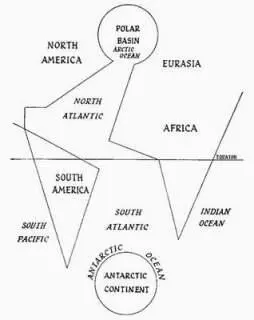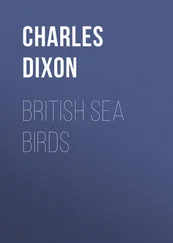The birds inhabiting the more northerly of these wedges, the North Atlantic, are the birds of this book. Two of these birds have become extinct in historical times: the great auk was never seen alive after 4 June, 1844, and the last Labrador duck was shot in 1875, though some say one was shot in 1878. The number of living species that remain is about one hundred and eighteen, of which eighty-six have been seen on the western seaboard of Europe (which includes Iceland), and ninety-three on the eastern seaboard of the New World (including Greenland).
However, for an understanding of the environment to which the North Atlantic birds are adapted, a description of the whole ocean is necessary, and to this we must proceed.
The extremely simple fundamental shape of the Atlantic invites diagrammatic caricature ( Fig. 1). It is the second largest ocean in the world. It is, on an average, over two and a quarter miles deep, and in some places nearly six. It is, on an average, three thousand five hundred miles across (maximum about five thousand); and is nine thousand miles long. Its area has been estimated as thirty-three million square miles, and its volume as seventy-five million cubic miles. It is a vast place, with many miles of coast, upon which much of civilization depends: considering its size, it has few islands. In comparison, the Indian Ocean is not quite as large (about twenty-eight million square miles); but the Pacific (about sixty-four million square miles) has nearly twice the area, and is ten thousand miles across its widest part. The Arctic Ocean (about five and a half million square miles) is small and nearly full of ice at all times of year; in spite of this it is at times very full of life. Finally, it is usual to describe the cold waters round the Antarctic Continent (itself the same size as the Arctic Ocean) as the Antarctic Ocean.
South of the normal steamship route from Britain to New York the Atlantic is almost everywhere over two miles deep, and in large areas more than three. But down mid-ocean, following the tropical kink in the zig-zag, runs a very long submarine ridge, above which is less than two miles of sea; it is only broken by deeps for a short distance on the Equator, and it rises to the surface in places—in the northern hemisphere at the Azores and St. Paul Rocks, and in the south at the lonely isles of Ascension, Tristan da Cunha and Gough. Other oceanic Atlantic islands, such as Bermuda in the north, and South Trinidad and St. Helena in the south, rise abruptly from very deep parts of the ocean. A sketch-chart will be found in Fig. 2 c .
It will be seen that there are prominent shallows along the east coast of southern South America, north of the mouths of the Amazon and along the Guianas, in parts of the Caribbean Sea and the Gulf of Mexico (there are also marked deeps in these tropical waters), off the New England States, Nova Scotia and (most particularly) Newfoundland, and round Britain, the Channel and the North Sea, and round Iceland. A submarine ridge, over which the sea is five hundred fathoms or less, cuts the North Atlantic entirely from the Norwegian Sea and the waters of the Polar Basin; Shetland, the Faeroes and Iceland lie on this ridge. Davis Strait is shallow, and the waters of Labrador and Hudson’s Bay very shallow. Where the waters are less than a hundred fathoms deep, what they cover is usually described as the Continental shelf. This has its own particular community of birds.
For practical purposes, and because all charts and maps mark the Arctic Circle and the Tropics, we have classified the North Atlantic and its birds into arctic, temperate and tropical areas based simply on latitude. In our analysis of breeding-distribution, for instance ( see here), we regard birds nesting north of the Arctic Circle as arctic, those nesting south of the Tropic of Cancer as tropical, and those nesting between as temperate. However, the temperature of neither air nor water arranges itself, in the Atlantic, according to latitude. * For instance, if we examine the July air isotherms over the world north of the Tropic of Cancer we see that that for 45° F. runs well south of the Arctic Circle in the areas Greenland-Baffin Island and Bering Strait, and well north of it off Scandinavia, avoiding Lapland altogether.

FIG. 1
Diagram of the Atlantic Ocean
If we examine a map of the world (showing particularly the lands between the Tropics), we see that the summer isotherm for 80°F. (July in the northern hemisphere, January in the southern) runs well north of the Tropic of Cancer in Mexico and the southern States, and in Africa and Asia, and south of the Tropic of Capricorn in Africa and Australia; yet large parts of the tropical Pacific and Atlantic Oceans never reach an average summer air temperature of 80°F.
In the North Atlantic there is not only relatively little direct correspondence between isotherms and latitude, but there is a good deal of difference in position between the same isotherms under the surface, on the water surface and in the air.
The primary cause of the ocean currents, and of the prevailing winds which are associated with them, is the rotation of the earth. The plot of the Atlantic currents and Atlantic winds is almost, though not quite, coincident. To a very large extent the distribution of Atlantic water temperatures, and to a large extent that of air temperatures, is a consequence of these currents and prevailing winds. However, in parts of the Atlantic evaporation and the melting of ice produces temperature and salinity gradients which themselves produce consequent currents. Hence the web of sequence and consequence, of cause and effect, becomes complex. We must examine the great equatorial current first, for almost every one of the more important sea masses in the Atlantic owes its existence to it. It is quite justifiable to write in terms of sea masses, for, as we shall see, the Atlantic waters are by no means homogeneous and can be divided, sometimes with strikingly sharp boundaries, into volumes possessing very diverse properties.
We need scarcely remind the reader that if he faces a globe, poised in the ordinary way with North at the top, and spins it as the earth naturally rotates, the points on its surface will travel, as they face him, from left to right. The points travelling with the greatest velocity will be those on the equator, and the two points represented by the Poles will travel with no velocity relative to the earth’s axis.
In general terms it is true that, as the earth rotates, its atmosphere rotates with it. However, there is a certain effect due to inertia or drag; and this effect, obviously, is greatest at the equator, where the surface velocity is greatest. The effect operates on all objects but can put only liquids and gases into a dynamic state. Upon these Corioli’s force—the deflecting force of the earth’s rotation—acts in a simple manner. It sets them in motion in a direction which, at the equator, is opposite that of the rotation of the earth. Thus if we examine a map of the prevailing winds and ocean currents of the world, we find pronounced positive east-to-west movements in all equatorial regions. The liquids and gases thus displaced circulate into the temperature regions and perform return movements in the higher latitudes where the Corioli’s force is less. Consequently, in the northern hemisphere water and wind currents tend to turn right-handed, whereas in the southern hemisphere they turn left-handed. (Exceptions to this rule are mostly found in minor seas, where the impact of the currents upon coasts may cause contra-rotation.) The main clockwise movement of the northern hemisphere wind and currents is very obvious.
Читать дальше













